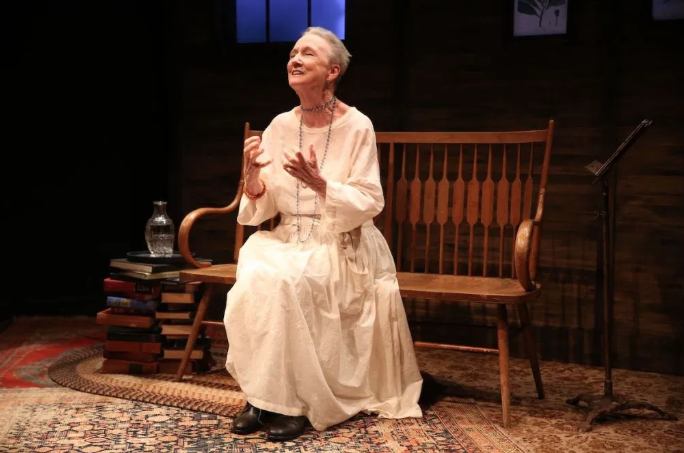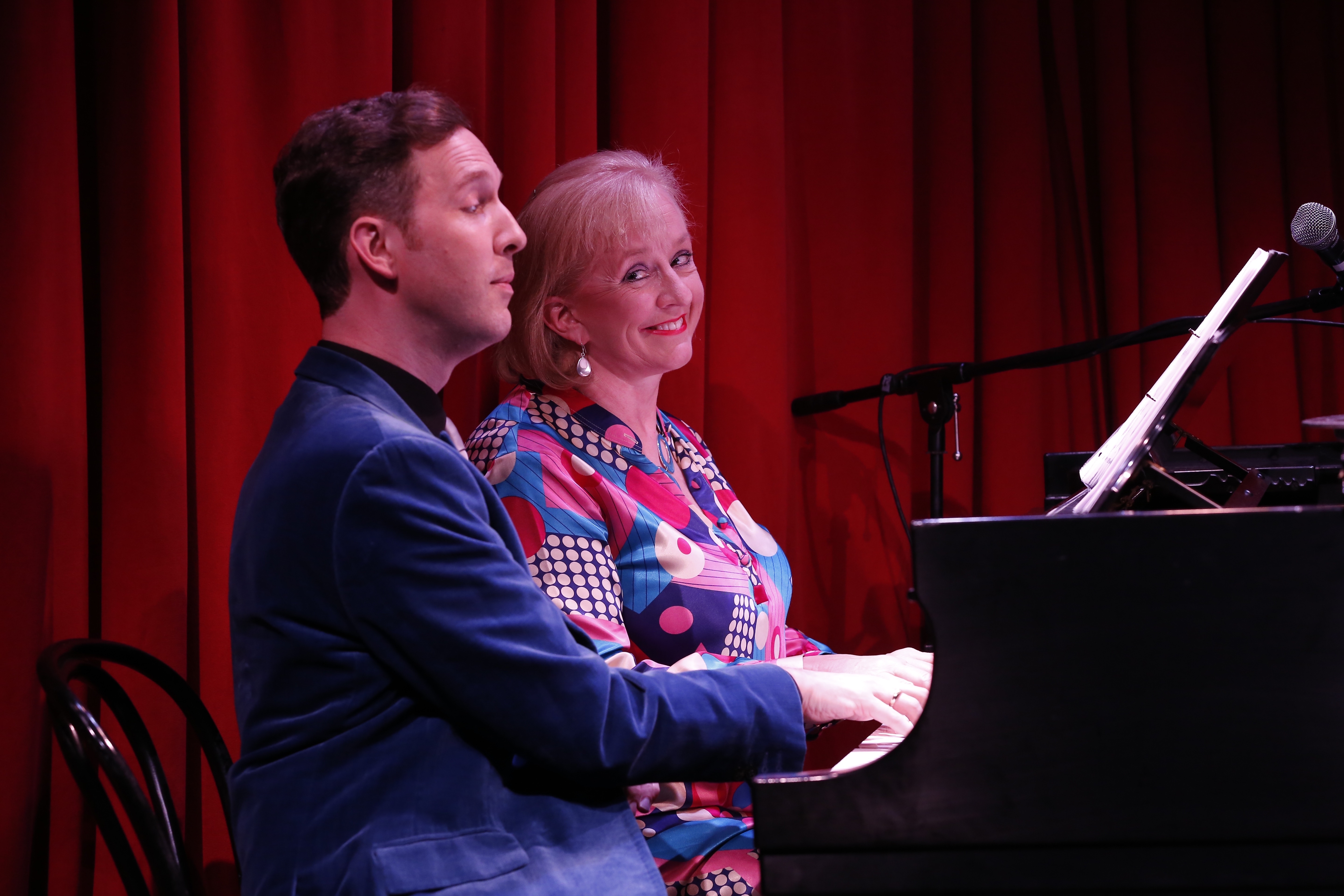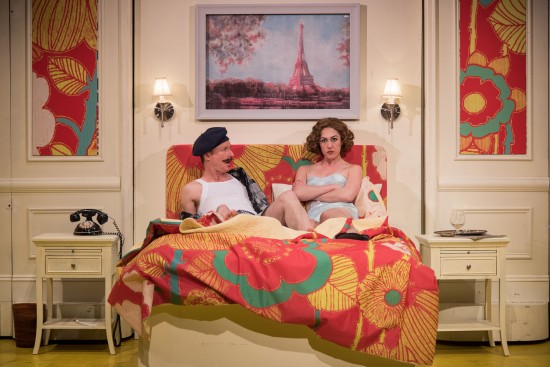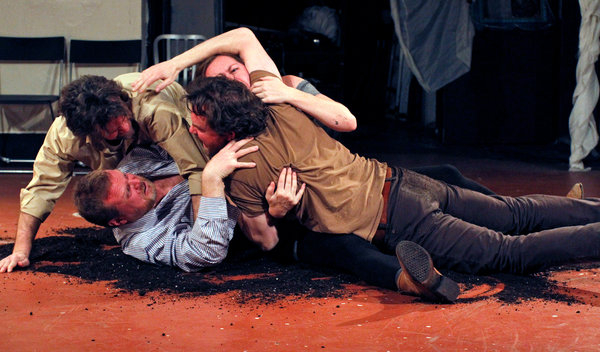By Samuel L. Leiter
The title of William Luce’s The Belle of Amherst used a posthumous nickname by which poet Emily Dickinson will long be remembered. We might, however, want to remember another belle of Amherst, the fascinating Mabel Loomis Todd (1856-1932), who now, thanks to playwright Rebecca Gilman and actress Kathleen Chalfant, is the subject of her own, workmanlike, one-woman play.
A Woman of the World, directed by Valentina Fratti and produced by The Acting Company in association with the Miranda Theatre Company, is presented in a tiny venue, where the audience of around 50 is imagined to be guests at a 1931 Todd lecture in the parlor of Point Breeze Inn. This is located in the only section of Hog Island, Maine, she doesn’t own. Unlike so many solo pieces, we’re at least given a justification for why the story is being told.
As Todd, the elegant Chalfant, one of New York’s most familiar actresses, creates the warm, witty, and commanding image of a 75-year-old woman recalling both her professional accomplishments and her extramarital affair. Her life, for a woman of her times, was progressive, to say the least, and, for a time, Gilman and Chalfant convey her tale with charm and humor. Nonetheless, the anecdotal current gradually loses dramatic force, giving sway to Morpheus’ fingertips.
Mabel is dressed by Candice Donnelly in an odd get-up of a long, beaded, necklace, a cameo brooch, hiking boots, and an off-white, ankle-length garment looking like a cross between a dress and an artist’s smock. Mabel was, indeed, an artist, as well as a musician, poet, novelist, travel writer, and, most importantly, the first editor of Dickinson’s poems.
Mabel admits this talk is her first in 18 years. She is giving her speech, “The Real Emily Dickinson,” prior to the publication of her expanded edition of Dickinson’s poems. She moves about on a platform (designed by Cate McRae and lit by Betsy Adams) backed by wooden paneling, fitted with a frosted window and dressed with paintings of a seagull and flora.
However, she decides instead to explore her own life, especially its intimate aspects, which she suggests is less boring. Her daughter, Millicent (herself an accomplished woman who, by then, would have been 51), is imagined in the auditorium, objecting to Mabel’s frank confessions, with Mabel pooh-pooing her concerns.
Naturally, most daughters wouldn’t wish to hear their mother publicly justifying an open relationship with a philandering husband. Mabel’s was David Peck Todd, an astronomer who studied solar eclipses and was a professor at Amherst College. Nor would they appreciate hearing an account of their mom’s 13-year love affair with another man, here Dickinson’s handsome brother, Austin.
Not only were Austin, David, and Mabel adulterers, they also, we’re informed, engaged in a four-way with Mabel’s cousin, Caro. In this sense, Mabel was, indeed, “a woman of the world,” a euphemism for socially daring females (who, for example, drank wine or showed their ankles). Mabel’s affair, of course, has been extensively written about, as in Polly Longsworth’s Austin and Mabel: The Amherst Affair & Love Letters of Austin Dickinson and Mabel Loomis Todd (2010).
As Mabel talks, often digressing into random recollections, some related to preserving Hog Island’s ecology, she reveals a big ego, both for her personal appeal (“men have always found me impossible to resist”) and her editorial work, whose process she describes. But she realizes , in the scheme of things, that she’s as insignificant as a “microscopic mite.”
A couple of questions arise. One is why, with Mabel grinding a bitter ax against her critics and other Dickinson editors, she never addresses the issue of herself having made unwarranted alterations in the poems. Another is why it’s necessary for her to declare that she and Emily were “fast friends,” only for her to later confess that they never actually met. For those who know something of the relationship, it’s a distraction that rattles around before the truth is revealed.
Ultimately, you’ll learn little in A Woman of the World about “the real Emily Dickinson,” but will learn something—unless you’ve done some research—about Mabel Loomis Todd. Whether that’s enough to justify this meandering play is questionable. Many will argue that if anybody can spin an ordinary script into theatrical gold, it’s Kathleen Chalfant. Nevertheless, even she can do only so much. A Woman of the World never matches the power of The Belle of Amherst, preventing Chalfant from doing for Mabel Loomis Todd what Julie Harris did for Emily Dickinson.
A Woman of the World 59E59 Theaters/Theater C – 59 E. 59th St., NYC Through November 17






















